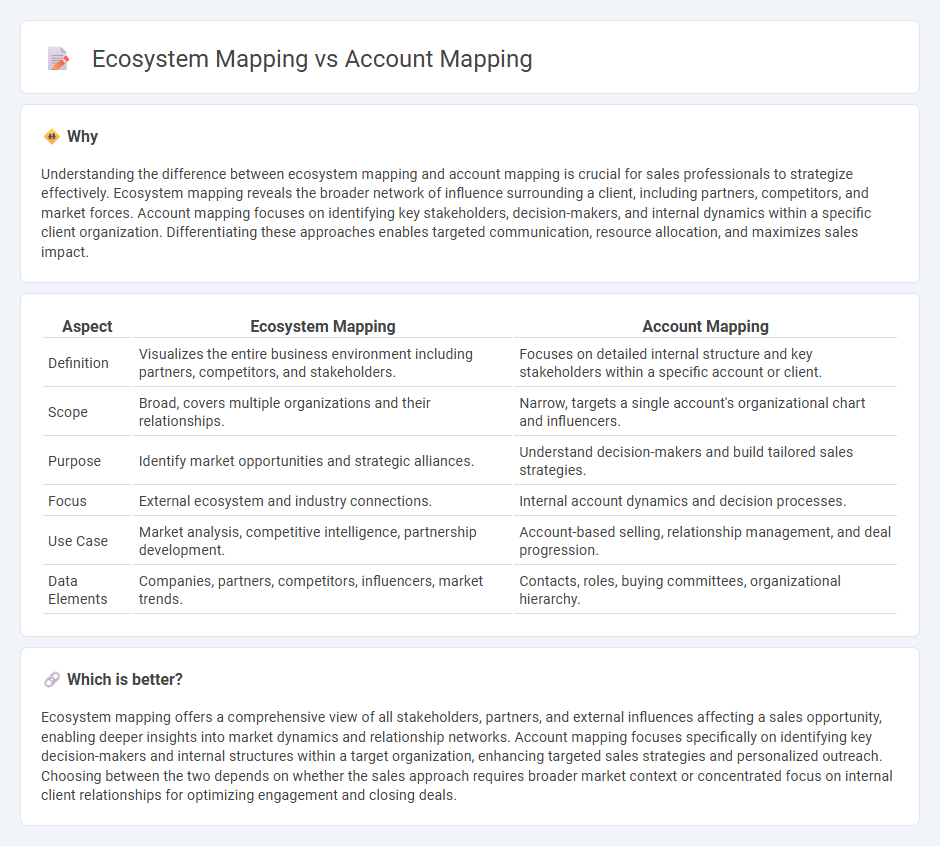
Sales ecosystem mapping identifies all relevant stakeholders, partners, and influencers within a market to understand broader business relationships and opportunities. Account mapping focuses on detailing key contacts, decision-makers, and internal dynamics within a specific target account to tailor sales strategies effectively. Explore how integrating both approaches can amplify your sales success.
Why it is important
Understanding the difference between ecosystem mapping and account mapping is crucial for sales professionals to strategize effectively. Ecosystem mapping reveals the broader network of influence surrounding a client, including partners, competitors, and market forces. Account mapping focuses on identifying key stakeholders, decision-makers, and internal dynamics within a specific client organization. Differentiating these approaches enables targeted communication, resource allocation, and maximizes sales impact.
Comparison Table
| Aspect | Ecosystem Mapping | Account Mapping |
|---|---|---|
| Definition | Visualizes the entire business environment including partners, competitors, and stakeholders. | Focuses on detailed internal structure and key stakeholders within a specific account or client. |
| Scope | Broad, covers multiple organizations and their relationships. | Narrow, targets a single account's organizational chart and influencers. |
| Purpose | Identify market opportunities and strategic alliances. | Understand decision-makers and build tailored sales strategies. |
| Focus | External ecosystem and industry connections. | Internal account dynamics and decision processes. |
| Use Case | Market analysis, competitive intelligence, partnership development. | Account-based selling, relationship management, and deal progression. |
| Data Elements | Companies, partners, competitors, influencers, market trends. | Contacts, roles, buying committees, organizational hierarchy. |
Which is better?
Ecosystem mapping offers a comprehensive view of all stakeholders, partners, and external influences affecting a sales opportunity, enabling deeper insights into market dynamics and relationship networks. Account mapping focuses specifically on identifying key decision-makers and internal structures within a target organization, enhancing targeted sales strategies and personalized outreach. Choosing between the two depends on whether the sales approach requires broader market context or concentrated focus on internal client relationships for optimizing engagement and closing deals.
Connection
Ecosystem mapping identifies the network of relationships among all stakeholders within a sales environment, while account mapping focuses specifically on the detailed structure and key contacts within a targeted client organization. Integrating ecosystem mapping with account mapping enhances strategic sales planning by revealing influence patterns, decision-making roles, and potential collaboration opportunities. This combined approach allows sales teams to tailor their engagement strategies, optimize resource allocation, and increase the likelihood of closing complex deals.
Key Terms
**Account Mapping:**
Account mapping involves identifying the key stakeholders, decision-makers, and influencers within a target organization to understand their roles, relationships, and purchasing authority. This process enables sales and marketing teams to tailor personalized strategies, improve engagement, and increase the likelihood of closing deals. Discover more about the benefits and techniques of effective account mapping.
Decision Makers
Account mapping identifies key decision makers and influencers within a single organization to tailor sales and marketing strategies effectively. Ecosystem mapping expands this by illustrating relationships and roles across multiple organizations, highlighting external decision makers critical to partnership and collaboration opportunities. Explore how combining these approaches can enhance your understanding of complex buying networks.
Organizational Structure
Account mapping focuses on identifying key stakeholders and decision-makers within a specific client organization to enhance sales strategies and customer relationships. Ecosystem mapping extends beyond a single account by analyzing the interconnected network of organizations, partners, suppliers, and competitors that influence the broader market environment. Explore deeper insights into how organizational structures impact both mapping approaches for effective business growth.
Source and External Links
What is Account Mapping? (Explained With Examples) - Account mapping is the process of visually representing key details about a customer or account--such as decision-makers, their roles, pain points, and relationship status--to tailor marketing and sales strategies more effectively.
What is Account Mapping, and Why Do You Need It (with Template) - Account mapping involves researching and organizing information about key stakeholders and influencers within a target organization to enable personalized engagement and identify partnership opportunities.
Account Mapping Definition & Meaning - PartnerStack - In partner ecosystems, account mapping is an ABM strategy where two partners combine customer data to uncover overlapping opportunities, accelerate sales, and strengthen strategic relationships, often using specialized software for visualization and analysis.
 dowidth.com
dowidth.com